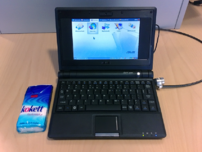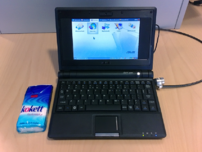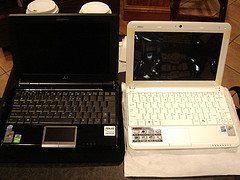CNet reports that the netbook is a hit with consumers, and likely will continue to be so for the foreseaable future. According to Displaysearch, they will comprise 20% of the 133 million notebooks to be shipped this year, amazing considering the netbook category had no market share in 2008. however, they predict consumers will return to buying notebooks with more features as the economy turns around.
We, and many others disagree with the idea that netbooks are popular because of the economy. That’s certainly a small part of it, but we bought one, and we are not alone, for the portability. For many years, a tiny, reasonably powerful notebook costs big bucks. A 14″ laptop always cost us more than the same laptop in a 15″.
Then comes the Eee, and launches the netbook category. We hate carrying around a 14-17″ laptop. It is portable, but most of the time, it is a pain to carry around. We don’t need a mobile computer for gaming. And even if we were gamers, we can have a computer at home to handle that. Netbooks are for productivity…perhaps video/sound on the go as well.
We wonder if the manufacturers see these machines differently than we do. Asus announced the upcoming Eee 1004DN, the first of the netbooks to offer a built-in optical drive. One of the best things about the netbook is the form factor. Adding an optical drive will turn it into a more efficient video playback system, if that is what someone wants, but it endangers the form factor. Already, the netbook has grown. Going from a 7″ screen to 9″ and 10″ was a good improvement, and did not increase the size incredibly, but additional weight of continually adding features, as well as increased costs, will eliminate the distinctiveness of the class.
Personally, we’ll just rip something and load it onto the hard drive or onto a flash card and stick it in the side. Otherwise, we have an external USB DVD burner we made out of a liberated notebook DVD drive and a converter case we bought online. It keps the equipment we have to carry to a minimum. We’re not the only ones who are concerned about the manufacturers destroying the idea of the netbook. The net is full of thoughts on the subject.
Continue to push the envelope, add in better low-power processors as they become available…improve the graphics, the screen build quality, the battery life. But keep the size and price points.
Meanwhile, OCZ launched a DIY netbook called the Neutrino. It has the standard netbook accoutrements…10 inch 1024×600 screen, Atrom N270, etc. Missing is a hard drive, RAM, multicard reader and an operating system, all of which you add as you wish. We’re in favor of customization, but the price point of $300 is a bit much for a system that doesn’t work out of the box considering the competition.
However, that said, many of the netbooks are not geared toward upgrades. The MSI Wind we bought has no slots on the bottom to open. You have to remove the whole bottom to access the hard drive. Some of the systems have the SSD drives or the RAM soldered onto the main board. Upgrade paths allow users to buy now, improve later.
Speaking of the Wind, MSI has announced the U123, a three pound laptop with a 6 or 9 cell battery, powered by the Atom N280 1.66Ghz CPU and the Intel 945GSE chipset. There’s 1GB of RAM expandable to 2GB, wireless, Bluetooth , camera, and a card reader. Essentially, the equivalent of the Eee 1000HE, although likely less expensive, as the Wind has been.
There’s more to say about netbooks. Next time, we’ll discuss how we outfitted our MSI Wind in more detail to make it the best it could be.

![Reblog this post [with Zemanta]](http://img.zemanta.com/reblog_c.png?x-id=b91992a3-5e0d-4006-a804-e3c6b2d46fc3)


![Reblog this post [with Zemanta]](http://img.zemanta.com/reblog_e.png?x-id=a93c807b-8365-402e-b3ce-5543c20edc4f)


![Reblog this post [with Zemanta]](http://img.zemanta.com/reblog_e.png?x-id=600f4ba9-4c16-4a27-9e3f-2cd7b5e643e2)


![Reblog this post [with Zemanta]](http://img.zemanta.com/reblog_e.png?x-id=61311da7-2ede-4dca-ab24-600da064aae0)